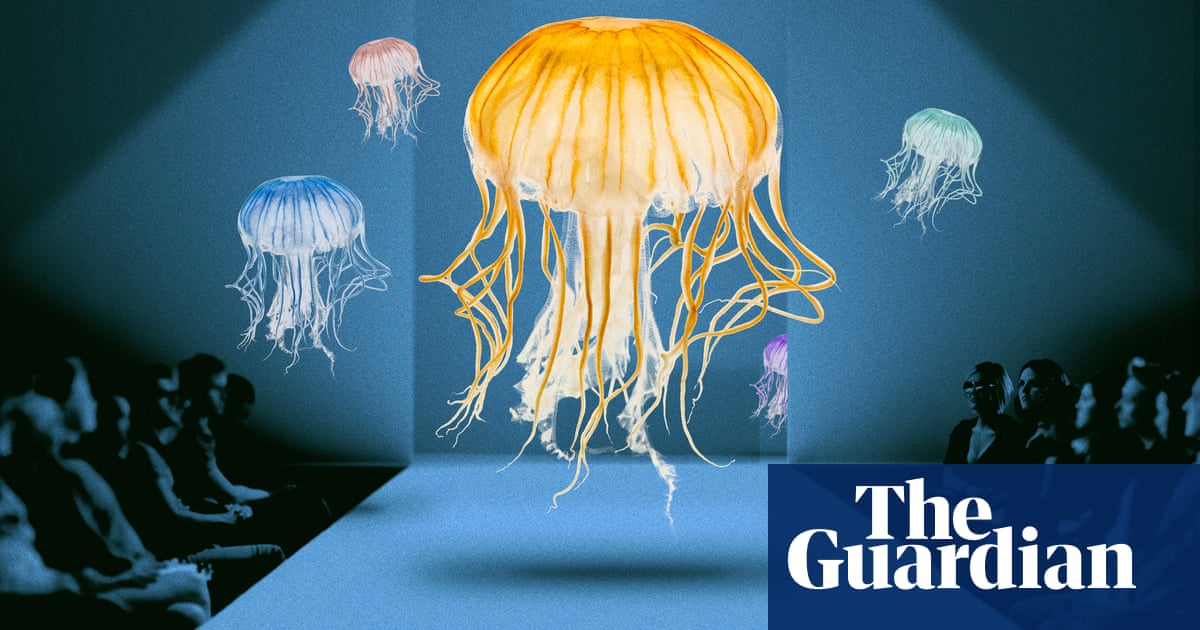They look extraterrestrial, beautiful and a bit gross – like aquatic blancmange or Compeed. They can be minuscule or have tentacles up to 36 metres long. And they are made up of 95% water. Yet, for creatures that don’t have brains, hearts, or lungs, we sophisticated humans draw an awful lot of inspiration from them. From fashion to interiors, the jellyfish has somehow propelled its way on to the collective creative moodboard this year.
Hunter Schafer looked like a gloriously iridescent jellyfish in a reflective satin Giorgio Armani Privé dress on the red carpet in Cannes this week. At the most recent Cos show in Rome, the final dress seemed to waft down the catwalk on a tide. Meanwhile, lamps that look like first cousins of Pacific Sea Nettles are trending, and Pinterest has flagged the jellyfish as a key trend for 2024.
In beauty, TikTok is full of tutorials teaching viewers how to create jellyfish-inspired makeup, from the literal, with tentacles drawn under the eye, to the subtle, with metallic eyes and pearlescent lips. And the haircut to get if you want to signal you know your Perelló from your Chin Chin is the jellyfish – the top layers a bob, the under layer left long; the more Portuguese Man O’ War the better.
This has all been bubbling up for some time. Ocean scientist-turned-science writer Juli Berwald, author of Spineless: the Science of Jellyfish and the Art of Growing a Backbone, first noticed that jellyfish were stretching their tentacles around 2015. The Google alert on her computer for “jellyfish”, presumably fishing for news of Blue jellyfish (Cyanea lamarckii) or Moon jellyfish (Aurelia aurita), sent news of the haircut her way. Then the lamps showed up, and the jellyfish art, themes and motifs in shop windows.
Given their sense of malice – the box jellyfish, famously, can kill in under five minutes – Berwald was a bit surprised. But then again, she says, they are “gorgeous to look at”.
She attributes their journey in part to advancements in jellyfish-keeping over the past 10 years. More delicate than their squidgy appearance would have you guess – they look as if they would bounce rather than crumble – any aquarium that houses them has to be round (with no corners or edges). But, as knowledge and skills have developed to the extent that more people are now able to watch them close up, jellyfish have gained a new appreciation. “People got to see them as this elegant, otherworldly, beautiful, diaphanous animal that moved with this kind of grace that you would admire or just get sucked into watching,” says Berwald.
“I think people are recognising that they’re really weird and really beautiful,” says Abigail McQuatters-Gollop, marine conservation ecologist and associate professor in marine conservation at Plymouth university, of the current mainstreamification of the invertebrate. “They come in all different sizes and all different shapes and all different colours.”
Their silhouette is also a gift. “Anyone with a sense of aesthetic would have to pause and say, ‘wow, what is that?’” says Berwald. Although she also says that the shape for which they are best known – the bell at the top and the tentacles that drift out, also known as the Medusa lifestage – is actually only one part of their life cycle.
after newsletter promotion
In fact underdogs of nature are having a moment – with plants and creatures previously considered a little odd, offbeat or outright ugly being rehabilitated. Take goblincore, which has helped mushrooms, toads and funghi enjoy a rare moment in the sun (as it were). The slimy jellyfish could be their oceanic cousins.
But this isn’t the first time that jellyfish have found fans. Berwald cites the work of jellyfish scientist and artist Ernst Haeckel, whose 1899 book Art Forms in Nature inspired a mainstream moment and spawned many of the art deco jellyfish motifs of the 1920s.
She draws a parallel with where we are now: “It was a time when I feel like humans were similarly struggling with, ‘what is our role on this planet and how do we interact with nature?’” As we “head into this period of intense climate change, we’re once again considering all of the forms of life on our planet, even those we’ve kind of forgotten, like the jellyfish.” As the idea of biophilia has caught on, Berwald believes that “some of these themes are showing up in our art forms as well. Like, recognising the beauty of these animals that we share our planet with.”
Photograph: Hannah McKay/Reuters
There is, of course, something paradoxical about fashion inspired by nature. The industry is, of course, famously bad for the planet, and jellyfish are not immune to the impacts of climate chaos, although they are, for all their delicacy, surprisingly resilient. As Berwald says, they are “among the oldest animals on our planet that still are alive,” at around 500 million years old.
There might also be an ironic parallel between the jellyfish and the current turbulent climate, as well as a feeling of disempowerment. A type of plankton, “they can’t swim against currents,” says McQuatters-Gollop. “They can squeeze their bowels, so they can move in the water column, in the water, but … they don’t really pick where they go.” It is a feeling that will speak to anyone who is currently feeling powerless against the tide. Who knew jellyfish were so relatable.







